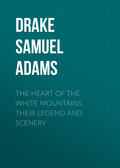
Drake Samuel Adams
Nooks and Corners of the New England Coast
Mather relates many anecdotes of Rev. John Brock, one of the early ministers at the islands, in illustration of the efficacy of prayer. The child of one Arnold, he says, lay sick, so nearly dead that those present believed it had really expired; "but Mr. Brock, perceiving some life in it, goes to prayer, and in his prayer uses this expression, 'Lord, wilt thou not grant some sign before we leave prayer that thou wilt spare and heal this child? We can not leave thee 'til we have it.' The child sneez'd immediately."
Going round the corner of the church, I came upon a coast pilot, peering through his glass for the smoke of a steamer, cable-freighted, that had been momentarily expected from Halifax for a week. His trim little boat lay in the harbor below us at her moorings. It was, he said, a favorite station from which to intercept inward-bound vessels. The pilot told me, with a quiet chuckle, of a coaster, manned by raw Irish hands, that had attempted in broad day to run into the harbor over the breakwater from Haley's to Cedar island. They did not get in, he said; but it being a full tide and smooth sea, the mole only knocked off the cut-water of their craft.
Behind the meeting-house is the little school-house, in as dire confusion when I saw it as any bad boy could have wished. The windows were shattered, chairs and benches overturned, and a section of rusty stove-pipe hung from the ceiling, while the fragment of a wall map, pressed into service as a window-curtain, was being scanned through the dingy glass by an urchin with a turn for geography.
East of the church is a row of cottages, the remnant of the fishing village, serving to show what it was like before modern innovations had swept the moiety of ancient Gosport from the face of the island. Each had a bird-house on the peak of its gable. There was the semblance of regularity in the arrangement of these cottages, the school-house leading the van; but they were nearly or quite all unpainted, these homely abodes of a rude people.
On looking around, you perceived walled inclosures, some of them containing a little earth patched with green grass, but all thickly studded with boulders. Is it possible, you ask, that such a waste should ever be the cause of heart-burnings, or know the name of bond, mortgage, or warranty? Little did these impoverished islanders dream the day would come when their sterile rocks would be eagerly sought after by the fortunate possessors of abundance.
Star Island formerly afforded pasturage for a few sheep and cows. There is a record of a woman who died at Gosport in 1795, aged ninety. She kept two cows, fed in winter on hay cut by her in summer with a knife among the rocks. The cows were taken from her by the British in 1775, and killed, to the great grief of old Mrs. Pusley. Formerly there was more vegetation here, but at odd times the poor people have gathered and burned for fuel fully half the turf on the island. It is written in the book of records that the soil of the islands is gradually decreasing, and that a time would come when the dead must be buried in the sea or on the main-land.
From the year 1775 until 1820, the few inhabitants who remained on the islands lived in a deplorable condition of ignorance and vice. Some of them had lost their ages for want of a record. Each family was a law to itself. The town organization was abandoned. Even the marriage relation was forgotten, and the restraints and usages of civilized life set at naught. Some of the more debased, about 1790, pulled down and burned the old meeting-house, which had been a prominent landmark for seamen; but, says the record, "the special judgments of Heaven seem to have followed this piece of wickedness to those immediately concerned in it." The parsonage-house might have fared as ill, had it not been floated away to Old York by Mr. Tucke's son-in-law.
Rev. Jedediah Morse has entered in the record two marriages solemnized by him during the time he was on the islands, with the following remarks: "The two couples above mentioned had been published eight or ten years ago (but not married), and cohabited together since, and had each a number of children. – had been formerly married to another woman; she had left him, and cohabited with her uncle, by whom she has a number of children. No regular divorce had been obtained. Considering the peculiar deranged state of the people on these islands, and the ignorance of the parties, it was thought expedient, in order as far as possible to prevent future sin, to marry them."105
It is perhaps as well the visitor should be his own guide about the islands, leaving it to chance to direct his footsteps. After an inspection of the more prominent objects, such as may be taken in at a glance from the little church, I wandered at will, encountering at every few steps some new surprise. Some one says, if we seek for pleasure it is pretty sure to elude our pursuit, coming, oftener to us unawares, and the more unexpected the higher the gratification. It was in some such mood I stumbled, to speak literally, on the old burial-place of the islands. I am aware that one does not, as a rule, seek enjoyment in a grave-yard; but I have ever found an unflagging interest in deciphering the tablets of a buried city or hamlet. These stones may be sententious or loquacious, pompous or humble, and sometimes grimly merry.
Our German friends call the church-yard "God's Field." Here are no inscriptions, except on the horizontal slabs of Tucke and Stephens. There is no difference between the rough stones protruding from the ground and the fragments strewn broadcast about the little house-lots. So far as this inclosure is concerned, the annals of the hamlet are as a closed book. The instinct which bids you forbear treading on a grave is at fault here. It requires sharp eyes and a close scrutiny to discover that some effort has been made to distinguish this handful of graves by head and foot stones; that some are of greater and some of lesser length; or that the little hollows and hillocks have their secret meaning.
The two shepherds lie at the head of their little fold, in vaults composed of the rude masses found ready at hand. For fear their inscriptions might one day be effaced, I transcribed them:
In Memory of
THE REV. JOSIAH STEPHENS,
A faithful Instructor of Youth, and pious
Minister of Jesus Christ
Supported on this Island by the
Society for Propagating the Gospel,
who died July 2, 1804
Aged 64 years
Likewise of
MRS. SUSANNAH STEPHENS,
his beloved Wife,
who died Dec. 7, 1810
Aged 54 years
Underneath
are the Remains of
THE REV. JOHN TUCKE, A.M
He graduated at Harvard College, a. d. 1723,
Was ordained here July 26, 1732,
And died Aug. 12, 1773
Æt. 72
He was affable and polite in his manner,
Amiable in his disposition,
Of great piety and integrity, given to hospitality,
Diligent and faithful in his pastoral office
Well learned in History and Geography, as well as
General Science,
And a careful Physician both to the bodies
and the souls of his People
Erected 1800
In Memory of the Just
For two-score years this pious man labored in his stony vineyard. His parishioners agreed to give him a quintal per man of winter fish – their best. They covenanted to carry his wood from the landing home for him. With this he was content. He was their minister, teacher, physician, and even kept the accounts of a little store in a scrupulously exact way. I have been poring over his old-time chirography, clear-cut and beautiful as copper-plate. There are the good old English names of Ruth, Nabby, and Judy, of Betty, Patsey, and Love. We get a glimpse of their household economy in the porringers, pewter lamps, and pint-pots; the horn combs, thread, tape, and endless rows of pins for women-folk; the knitting-needles that clicked by the fireside in long winter nights, while the lads were away on Jeffrey's Ledge.
From here I wended my way to Smith's monument, erected in 1864, a triangular shaft of marble, rising eight or ten feet above a craggy rock. It is placed on a pedestal of rough stone, and protected by a railing from vandal hands. Its situation on one of the highest eminences of Star Island has exposed the inscription to the weather, until it is become difficult to decipher. The three sides of the pillar are occupied by a lengthy eulogium on this hero of many adventures,
"Of moving accidents by flood and field;
Of hair-breadth scapes i' the imminent deadly breach."
Like Temple Bar of old, the monument is crowned with heads – those of the three Moslems slain by Smith, and seen on his scutcheon, as given by Stow, where they are also quartered. I know of no other instance of decapitated heads being set up in New England since King Philip's was struck off and stuck on a pike at Plymouth, in 1676. Two of the heads had fallen down, and the third seemed inclined to follow. Then the monument will be as headless as the doughty captain's tombstone in the pavement of St. Sepulchre's, worn smooth by many feet. In brief, the three Turks' heads stick no better than the name given by Smith to the islands off Cape Ann – after they had been named by De Monts.
Smith says he had six or seven charts or maps of the coast so unlike each other as to do him no more good than waste paper. He gives credit to Gosnold and Weymouth for their relations.
A few rods south-east of the old burying-ground is a sheltered nook, in which are three little graves, wholly concealed by dwarf willows and wild rose-bushes. They are tenanted by three children – "Jessie," two years; "Millie," four years; and "Mittie," seven years old – the daughters of Rev. George Beebe, some time missionary to these isles. Under the name of the little one last named are these touching, tearful words: "I don't want to die, but I'll do just as Jesus wants me to." A gentle hand has formed this retreat, and protected it with a wooden fence. While I stood there a song-bird perched above the entrance and poured forth his matin lay. There is a third burial-place on the harbor side, but it lacks interest.
Another historic spot is the ruined fort, on the west point of the island, overlooking the entrance to the roadstead. Its contour may be traced, and a little of the embankment of one face remains. The well was filled to the curb with water. It once mounted nine four-pounder cannon, but at the beginning of the Revolution was dismantled, and the guns taken to Newburyport. I suppose the inhabitants for a long time to have neglected precautions for defense, as Colonel Romer, in his report to the Lords of Trade, about 1699, makes no mention of any fortification here. One of its terrible four-pounders would not now make a mouthful for our sea-coast ordnance.
Continuing my walk by the shore, I came to the cavern popularly known as Betty Moody's Hole. It is formed by the lodgment of masses of rock, so as to cover one of the gulches common to the isle. Here, says tradition, Betty concealed herself, with her two children, while the Indians were ravaging the isles and carrying many females into captivity. The story goes that the children, becoming frightened in the cavern, began to cry, whereat their inhuman mother, in an excess of fear, strangled them both; others say she was drowned here. The affair is said to have happened during Philip's War. I do not find it mentioned by either Mather or Hubbard.106 At times during the fishing season there was hardly a man left upon the islands, a circumstance well known to the Indians.
A memoir extracted from the French archives gives a picture of the Isles in 1702, when an attack appears to have been meditated. "The Isles de Chooles are about three leagues from Peskatoué to the south-south-east from the embouchure of the river, where a great quantity of fish are taken. These are three isles in the form of a tripod, and at about a musket-shot one from the other." * * * "There are at these three islands about sixty fishing shallops, manned each by four men. Besides these are the masters of the fishing stages, and, as they are assisted by the women in taking care of the fish, there may be in all about two hundred and eighty men; but it is necessary to observe that from Monday to Saturday there are hardly any left on shore, all being at sea on the fishing-grounds."
Taking note of the ragged fissures, which tradition ascribes to the day of the Crucifixion, I clambered down one of the rocky gorges from which the softer formation has been eaten out by the consuming appetite of the waves. Sometimes the descent was made easy by irregular steps of trap-rock, and again a flying leap was necessary from stone to stone. The perpendicular walls of the gorge rose near fifty feet at its outlet, at the shore. It was a relief to emerge from the dripping sides and pent-up space into the open air. The Flume, on Star Island, is a fine specimen of the intrusion of igneous rock among the harder formation.
If you would know what the sea can do, go down one of these gulches to the water's edge and be satisfied. I could not find a round pebble among the débris of shattered rock that lay tumbled about; only fractured pieces of irregular shapes. Those rocks submerged by the tide were blackened as if by fire, and shagged with weed. Overhead the precipitous cliffs caught the sun's rays on countless glittering points, the mica with which they are so plentifully bespangled dazzling the eye with its brilliancy. Elsewhere they were flint, of which there was more than enough to have furnished all Europe in the Thirty Years' War, or else granite. Looking up from among the abattis which girds the isle about, you are confronted by masses of overhanging rocks that threaten to detach themselves from the cliff and bury you in their ruins.
It is not for the timid to attempt a ramble among the rocks on the Atlantic side at low tide. He should be sure-footed and supple-jointed who undertakes it, with an eye to estimate the exact distance where the incoming surf-wave is to break. The illusions produced in the mind by the great waves that roll past are not the least striking sensations experienced. The speed with which they press in, and the noise accompanying their passage through the gullies and rents of the shore, contribute to make them seem much larger than they really are. It was only by continually watching the waves and measuring their farthest reach that I was able to await one of these curling monsters with composure; and even then I could not avoid looking suddenly round on hearing the rush of a breaker behind me; and ever and anon one of greater volume destroyed all confidence by bursting far above the boundaries the mind had assigned for its utmost limits.
Nothing struck me more than the idea of such mighty forces going to pure waste. A lifting power the Syracusan never dreamed of literally throwing itself away! An engine sufficient to turn all the machinery in Christendom lying idle at our very doors. What might not be accomplished if Old Neptune would put his shoulder to the wheel, instead of making all this magnificent but useless pother!
I noticed that the waves, after churning themselves into foam, assumed emerald tints, and caught a momentary gleam of sapphire, melting into amethyst, during the rapid changes from the bluish-green of solid water to its greatest state of disintegration. The same change of color has been observed in the Hebrides, and elsewhere.
The place that held for me more of fascination and sublimity than others was the bluff that looks out upon the vast ocean. I was often there. The swell of the Atlantic is not like the long regular roll of the Pacific, but it beats with steady rhythm. The grandest effects are produced after a heavy north-east blow, when the waves assume the larger and more flattened form known as the ground-swell. I was fortunate enough to stand on the cliff after three or four days of "easterly weather" had produced this effect. Such billows as poured with solid impact on the rocks, leaping twenty feet in the air, or heaped themselves in fountains of boiling foam around its base, give a competent idea of resistless power! The shock and recoil seemed to shake the foundations of the island.
Upon a shelf or platform of this cliff a young lady-teacher lost her life in September, 1848. Since then the rock on which she was seated has been called "Miss Underhill's Chair." Other accidents have occurred on the same spot, insufficient, it would seem, to prevent the foolhardy from risking their lives for a seat in this fatal chair.
There are circumstances that cast a melancholy interest around the fate of Miss Underhill. In early life she had been betrothed, and the banns, as was then the custom, had been published in the village church. Her father, a stern old Quaker, opposed the match, threatening to tear down the marriage intention rather than see his daughter wed with one of another sect. Whether from this or other cause, the suitor ceased his attentions, and not long after took another wife in the same village.
The disappointment was believed to have made a deep impression on a girl of Miss Underhill's strength of character. She was a Methodist, deeply imbued with the religious zeal of that denomination. Hearing from one who had been at the Isles of Shoals that the people were in as great need of a missionary as those of Burmah or of the Gold Coast, it became an affair of conscience with her to go there and teach.
She came to the islands, and applied herself with ardor to the work before her, a labor from which any but an enthusiast would have recoiled. It is asserted that no spot of American soil contained so debased a community as this.
It was her habit every pleasant day, at the close of school, to repair to the high cliff on the eastern shore of Star Island, where a rock conveniently placed by nature became her favorite seat. Here, with her Bible or other book, she was accustomed to pass the time in reading and contemplation. She was accompanied on her last visit by a gentleman, erroneously thought to have been her lover, who ventured on the rock with her. A tidal wave of unusual magnitude swept them from their feet. The gentleman succeeded in regaining his foothold, but the lady was no more seen.
Search was made for the body without success. A week after the occurrence it was found on York Beach, where the tide had left it. There was not the least disorder in the ill-fated lady's dress; the bonnet still covered her head, the ear-rings were in her ears, and her shawl was pinned across her breast. In a word, all was just as when she had set out for her walk. The kind-hearted man who found the poor waif took it home, and cared for it as if it had been his own dead. An advertisement caught the eye of Miss Underhill's brother. She was carried to Chester, New Hampshire, her native place, and there buried.
Notwithstanding the humble surroundings of her home, Miss Underhill was a person of superior and striking appearance. Her face was winning and her self-possessed manner is still the talk of her old-time associates. I have heard, as a sequel to the school-teacher's story, that some years after the fatal accident her old suitor came to the Isles, and, while bathing there, was drowned. The recovery of the body of the lady uninjured seems little short of miraculous, and confirms the presence of a strong under-tow, as I had suspected on seeing the floats of the lobstermen moored within a few feet of the rocks.
Schiller may have stood, in imagination, on some such crag as this when his wicked king flung his golden goblet into the mad sea, and with it the life of the hapless stripling who plunged, at his challenge, down into
"The endless and measureless world of the deep."
In a neighboring ravine I found a spring of fresh water, though rather brackish to the taste; and in the more sheltered places were heaps of mussel-shells, the outer surface of a beautiful purple. They look better where they are than in my cabinet, though the lining of those I secured have an enamel of mother-of-pearl. Another remarkable feature I observed were the deposits of gravel among the crevices; but I saw no flint among the water-worn boulders wedged, as if by a heavy pressure, in fissures of the rocks. I remarked also the presence of a poor schistus intersecting the strata here and there. Some of it I could break off with my hands.
Another delightful ramble is on the harbor side, from the old fort round to Caswell's Peak or beyond. Passing by the little hand-breadth of sandy beach where the dories may land, once paved, the chronicles tell us, many feet deep with fish-bones, I observed with pleasure the green oasis spread out between the hotel and the shore. The proprietor seemed resolved that the very rocks should blossom, and already "a garden smiled" above the flint.
There is a sight worth seeing from the cupola of the hotel; of the White Hills, and Agamenticus, with the sands of Rye, Hampton, and Squam stretching along shore. I could see the steeples of Portsmouth and of Newburyport, the bluff at Boar's Head, and the smoke of a score of inland villages. Following with the eye the south coast where it sweeps round Ipswich Bay one sees Cape Ann and Thatcher's Island outlying; the gate-way of the busy bay beyond, into which all manner of craft were pressing sail. Northward were Newcastle, Kittery, and York, and farther eastward the lonely rock of Boon Island. Shoreward is Appledore, with the turret of its hotel visible above; and right below us the little harbor so often a welcome haven to the storm-tossed mariner.107
Most visitors to the islands are familiar with the terrible story of the wreck of the Nottingham galley, of London, in the year 1710. She was bound into Boston, and having made the land to the eastward of the Piscataqua, shaped her course southward, driven before a north-east gale, accompanied with rain, hail, and snow. For ten or twelve days succeeding they had no observation. On the night of the 11th of December, while under easy sail, the vessel struck on Boon Island.
With great difficulty the crew gained the rocks. The ship having immediately broken up, they were able to recover nothing eatable, except three small cheeses found entangled among the rock-weed. Some pieces of the spars and sails that came ashore gave them a temporary shelter, but every thing else had been carried away from the island by the strong drift. In a day or two the cook died. Day by day their sufferings from cold and hunger increased. The main-land being in full view before them, they built a boat and got it into the water. It was overset, and dashed in pieces against the rocks. One day they descried three boats in the offing, but no signals they were able to make could attract notice. Then, when reduced to a miserable band of emaciated, hopeless wretches, they undertook and with great labor constructed a raft, upon which two men ventured to attempt to reach the shore. Two days afterward it was found on the beach, with one of its crew lying dead at some distance. After this they were obliged to resort to cannibalism in order to sustain life, subsisting on the body of the carpenter, sparingly doled out to them by the captain's hand. To make an end of this chapter of horrors, the survivors were rescued after having been twenty-four days on the island. The raft was, after all, for them a messenger of preservation, for it induced a search for the builders.
No one can read this narrative without feeling his sympathy strongly excited for the brave John Deane, master of the wrecked vessel. He seemed possessed of more than human fortitude, and has told with a sailor's simple directness of his heroic struggle for life. His account was first published in 1711, appended to a sermon by Cotton Mather. Deane afterward commanded a ship of war in the service of the Czar, Peter the Great.108
Few who have seen the light-house tower on this lonely rock, distant not more than a dozen miles from the coast, receiving daily and nightly obeisance of hundreds of passing sails, can realize that the story of the Nottingham could be true. It is a terrible injunction to keep the lamps trimmed and brightly burning.109
Proceeding onward in this direction, I came to the fish-houses that remain on the isle. Tubs of trawls, a barrel or two of fish-oil, a pile of split fish, and the half of a hogshead, in which a "kentle" or so of "merchantable fish" had just been salted down, were here and there; a hand-barrow on which to carry the fish from the boat, a lobster-pot, and a pair of rusty scales, ought to be added to the inventory. Sou'-westers and suits of oil-skin clothing hung against the walls; and in the loft overhead were a spare block or two and a parcel of oars, evidently picked up adrift, there being no two of the same length. In some of the houses were whale-boats, that had been hauled up to be calked and painted, that the men were preparing to launch. They were all schooner-rigged, and some were decked over so as to furnish a little cuddy for bad weather. No more sea-worthy craft can be found, and under guidance of a practiced hand one will sail, as sea-folk say, "like a witch." They usually contained a coil of half-inch line for the road, a "killick," and a brace of powder-kegs for the trawls.
The process of curing, or, as it is called by the islanders, "saving," fish is familiar to all who live near the sea-shore, and has not changed in two hundred years. It is described as practiced here in 1800, by Dr. Morse:
"The fish, in the first place, are thrown from the boat in piles on the shore. The cutter then takes them and cuts their throat, and rips open their bellies. In this state he hands them to the header, who takes out the entrails (detaching the livers, which are preserved for the sake of the oil they contain), and breaks off their heads. The splitter then takes out the backbone, and splits them completely open, and hands them to the salter, who salts and piles them in bulk, where they lie from ten to twenty hours, as is most convenient. The shoremen and the women then wash and spread them on the flakes. Here they remain three or four weeks, according to the weather, during which time they are often turned, piled in fagots, and then spread again, until they are completely cured for market."
The "dun," or winter fish, formerly cured here, were larger and thicker than the summer fish. Great pains were taken in drying them, the fish-women often covering the "fagots" with bed-quilts to keep them clean. Being cured in cold weather, they required but little salt, and were almost transparent when held up to the light. These fish sometimes weighed a hundred pounds or more. The dun fish were of great esteem in Spain and in the Mediterranean ports, bringing the highest price during Lent. They found their way to Madrid, where many a platter, smoking hot, has doubtless graced the table of the Escurial. In 1745 a quintal would sell for a guinea.
In 1775 the revolting colonies, unable to protect the islands, ordered their abandonment. A few of the inhabitants remained, but the larger number removed to the near main-land, and were scattered among the neighboring towns. The Shoals became through the war a rendezvous for British ships. The last official act of the last royal governor of New Hampshire was performed here in 1775, when Sir John Wentworth prorogued the Assembly of his majesty's lost province.







